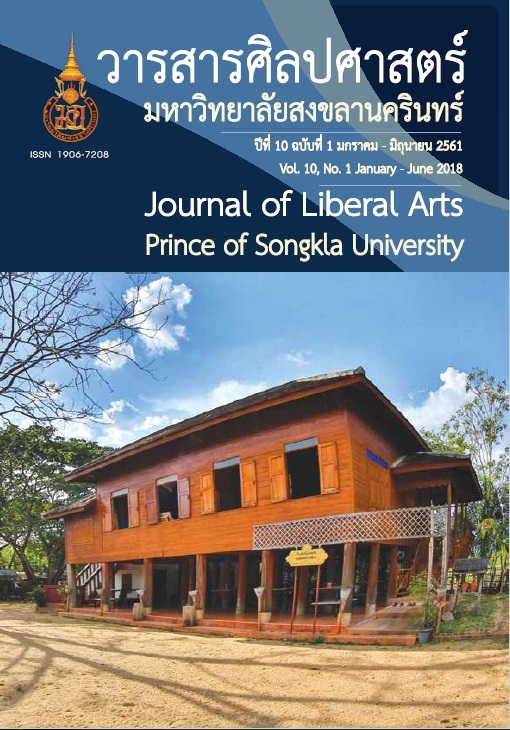Discourse on psychiatric disorders in modern Thai literature: A study of Piyaporn Saksasem’s novels
Keywords:
Discourse, psychiatric disorder, Thai novels, Piyaporn SakkasemAbstract
This study aimed to explore the presentation of psychiatric disorders and discourse towards mental illness presented in Piyaporn Sakkasem’s novels published from 1993 - 2013. The study design was documentary research using a qualitative approach, represented by descriptive analysis. There were 6 novels included in the study.
The main findings were that most of the characters exhibited psychiatric symptoms after unfavorable behaviors, such as premature sexual relations and substance abuse. The novels also generally suggested that the causes of the psychiatric illnesses in those who behaved favorably originated from “outside” as they were usually victims of physical or mental abuse, whilst characters who conducted unfavorable behaviors were motivated from “inside” themselves. The novels similarly revealed psychiatric disorders as the “outcome” of the character’s negative behaviors in the past. These literary techniques may have an impact on attaching a negative meaning to psychiatric disorders, such as the disease of a “sinner” or a “victim”. Moreover, the novels displayed changed representations of mental diseases during 20 years of publishing, which may characterize changes in the discourse of psychiatric disorders in modern Thai literature as well.
References
Boonkhachorn, T. (2004). The novel and Thai society. Bangkok: Chulalongkorn.
[In Thai]
Bunmi, T. (2014). Michel Foucault. Bangkok: Wiphasa. [In Thai]
Charoensin-o-larn, C. (1999). Development discourse: power knowledge truth identity and otherness. Bangkok: Krirk University. [In Thai]
Charuchinda, A. (2012). The construction of the femininity in Thai novels during Field Marshal P. Phibulsongkram’s regime. Saint John Journal, 15(17), 149-166. [In Thai]
Chotiudompant, S. (2005). Magical realism in Thai Literature and discourse of otherness. Journal of Letters, 34(2), 84-106. [In Thai]
Chotiudompant, S. (2008). Discourse, representation and identity. Journal of Letters, 37(1), 1-15. [In Thai]
Culler, J. D. (2002). Barthes: A very short introduction. Oxford, United Kingdom: Oxford University Press.
Danaher, G., Schirato, T. & Webb, J. (2000). Understanding Foucault. London: Sage Publications.
Depression Health Center. (2016). Signs of clinical depression: Symptoms to watch for. Retrieved April 20, 2016, from http://www.webmd.
Com/depression /guide/detecting-depression.
Foucault, M. & HOWARD, R. J. (1967). Madness and civilization: A history of insanity in the Age of Reason; translated by Richard Howard. (Abridged.). London: Tavistock Publications.
Jatchavala, C. (2013). Discourse and stigmatization of psychiatric disorder in Thailand. Journal of Sociology and Anthropology, 32(2), 93-113. [In Thai]
Laphiratanakul, P. (1997). Dokmai nai panao: representation of Thai society. Sakulthai, 2196, 30-33. [In Thai]
Pingkhalasay, C. (2015). From DSM-IV-TR to DSM-5: what has changed in the child. Bullentin of Suanprung, 31(3), 63-68. [In Thai]
Pinsuwan, N. (1988). An Analysis of characters in Botan's novels (Master’s thesis). Srinakarinwirot University, Bangkok, Thailand. [in Thai]
Pocapanishwong, A. (2009). Psychiatric discourse, and the social negotiation
of the mentally ill in Isan locality. Journal of Mekong Societies, 5(3), 107-136. [In Thai]
Prachakul, N. (2009). Yok akson yon khwamkhit (2nded.). Bangkok: Samnakphiman. [In Thai]
Sakgasem, P. (1999). Dokmai nai pa nao (5th ed.). Bangkok: Double Nine Printing. [In Thai]
Sakgasem, P. (2001). Ban lang saeng duean. Bangkok: Double Nine Printing. [In Thai]
Sakgasem, P. (2002). Lap lae lai mek. Bangkok: Double Nine Printing.
[In Thai]
Sakgasem, P. (2005). Nai wan wan. Bangkok: Arun. [In Thai]
Sakgasem, P. (2010). Lam nam nai lom nao. Bangkok: Arun. [In Thai]
Sakgasem, P. (2012). Khop fa ratri. Bangkok: Arun. [In Thai]
Sawasdee, B. (2007). Characteristics of Piyaporn Sakgasem's novels (Master’s thesis), Chulalongkorn University, Bangkok). [In Thai]
Sitdhiraksa, N. et al. (2015). Siriraj Psychiatry DSM-5. Bangkok: Department of Psychiatry, Faculty of Medicine, Siriraj Hospital, Mahidol University. [In Thai]
Sutiwipakorn, W. (2009. Michel Foucault's discourse on Thai women's status and roles as represented in Khunying Wimol Siripaiboon's novels. Journal of Human Sciences, 10(1), 1-16. [In Thai]
Tuntavanitch, P. (1978). The concept of Thai people concerning main characters in Thai literature textbooks (Master's thesis). Chulalongkorn University, Bangkok. [In Thai]
Woraseeha, K. (2012). Representation of the good and the bad from political demonstration news reported in Thai newspaper (Master’s thesis). Srinakarinwirot University, Bangkok, Thailand. [In Thai]
Downloads
Published
How to Cite
Issue
Section
License
The authors retain the copyright to their article but the Journal of Liberal Arts, Prince of Songkla University reserves the exclusive rights to first publication.






